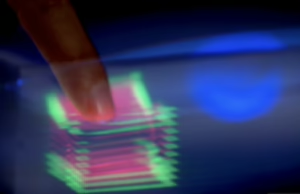Researchers at the Universidad Pública de Navarra have created something that feels almost like science fiction: a 3D display you can actually reach into with your bare hands. Called FlexiVol, this system lets users interact directly with virtual content floating in space, no headsets, gloves, or controllers required. It marks a shift in how we might engage with digital environments, offering a more hands-on, natural experience.

FlexiVol builds on the principle of swept volumetric displays, which project 2D slices onto a moving diffuser to form a 3D image. These images are created through persistence of vision. Conventional systems use a rigid diffuser that prevents physical interaction. FlexiVol replaces this component with a set of elastic strips, allowing users to insert their hands into the display volume and interact with rendered objects.
The system uses a projector and oscillating diffuser strips to form the 3D image. The projector outputs slices at high frame rates, synchronized with the movement of the diffuser. The elastic diffuser enables direct physical interaction without damaging the display or harming the user.
The researchers tested several materials for use as the diffuser. These included elastane, silicone, and projection fabrics. They evaluated each based on optical performance, stiffness, frequency response, and deformation. Elastic bands composed of polyester and elastane were selected due to their performance across all tests.
To address visual distortion caused by the movement of the elastic diffuser, the team developed a correction algorithm. This model predicts the shape of the diffuser at any point during oscillation and adjusts the projected image accordingly. A polynomial function is applied to correct mesh vertices, preserving the integrity of the 3D content.
FlexiVol allows users to reach through the diffuser to manipulate 3D content. Interactions occur when users touch or pass between diffuser strips. The system supports gestures such as grasping, pinching, pushing, rotating, and sliding. These gestures map to actions like selection, scaling, movement, and tracing.
The system does not use abstract metaphors or indirect control schemes. The alignment between hand position and rendered objects allows for interactions that follow physical movement patterns.
A study with 18 participants compared FlexiVol with a 3D mouse. Participants completed three tasks: selection, tracing, and docking. The study measured completion time, positional accuracy, and perceived workload. Reach-through interaction resulted in faster completion times and reduced cognitive workload. Accuracy was slightly reduced compared to the 3D mouse. Most participants preferred using their hands. Several noted that interaction felt more familiar and did not require explanation.
Participants also reported that inserting their hands into the display felt safe and comfortable. Some described sensations from the oscillating diffuser. A few expressed interest in expanded gesture options, such as using both hands or more complex motions.
FlexiVol could be used in modeling, visualization, education, games, and medical training. Participants suggested potential uses such as surgery planning, collaborative design, and digital content manipulation. The display system also produces less noise than conventional setups using rigid components.
Reference
Bouzbib, E., Sarasate, I., Fernandez, U., Fernandez, I., López-Amo, M., Ezcurdia, I., & Marzo, A. (2025, April). FlexiVol: A Volumetric Display with an Elastic Diffuser to Enable Reach-Through Interaction. Proceedings of the CHI Conference on Human Factors in Computing Systems (CHI’25). https://doi.org/10.1145/3706598.3714315

